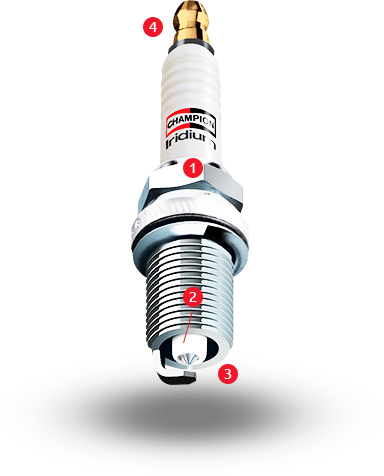Choosing the right Spark Plug for your engine is crucial. In the below section, you'll find more information that aims to guide you in choosing the right product for your car and to help you understand the importance of certain technological features.
How does a Spark Plug work?
Petrol-driven engines have spark plugs, diesel-driven engines have glow plugs, that's the starting point. The ignition system on petrol-driven engines is external: during the compression cycle the combustion of the compressed fuel-air mixture is triggered by an electrical spark produced by the spark plug.
The Spark Plug creates this spark
Created by the high voltage produced by the ignition coil, it leaps between the electrodes. A flame front spreads from the spark and fills the combustion chamber until the mixture has been burned. The heat released increases the temperature, there is a rapid buildup of pressure in the cylinder and the piston is forced downwards. The movement is transferred via the connecting rod to the crankshaft; this drives the vehicle via the clutch, the gears and the axles.
Spark Plug Requirements
In order for the engine to operate smoothly, powerfully and in an environmentally friendly manner the correct amount of perfectly balanced fuel/air mixture must be present in the cylinder, and the high-energy ignition spark must leap between the electrodes precisely at the predetermined moment. For this purpose spark plugs have to meet the highest performance requirements: they must deliver a powerful ignition spark during hours of driving at high revs or in stop-and-go traffic conditions. Even at -20 °C, they have to ensure a completely reliable ignition. High-tech spark plugs provide low-emission combustion and optimum fuel efficiency. Champion® spark plugs are designed and manufactured using high quality materials to consistently meet these extreme requirements.
Look inside the Technology: What's in a Spark Plug?
EVERY CHAMPION®SPARK PLUG IS COMPOSED OF FIVE MAIN COMPONENTS

In today’s plugs, a resistor is built in to eliminate radio frequency interference.
- The shell is a threaded metal hex (made from extruded steel) that seals the combustion and makes it possible to install or remove the plug. Each spark plug has its particular heat range.
- The insulator prevents secondary ignition voltage grounding anywhere else — other than the gap — and it moves the heat from the combustion process to the cylinder head (and into the cooling system).
- The ground and centre electrodes position the spark in the ignition chamber. The gap is the distance between the centre and the ground electrode. This is what the ignition spark must jump across.
- Finally, the terminal connects the plug to the ignition system.
Durability defined by components
The performance and durability of a spark plug is determined by the characteristics of each of its parts. That's a fact. So in order to provide you with the most complete range of spark plugs, Champion®resorts to using a variety of components. Their usage is the result of technological development and serves to ensure the durabilty that the inherent features of these components can guarantee. In a nutshell, the different elements used to build spark plug will, each in their own way, influence the life cycle and performance of the product. Champion®states the technical features and components of each product on its packaging so that you have all the useful information you need to best choose the right spark plug for your application.